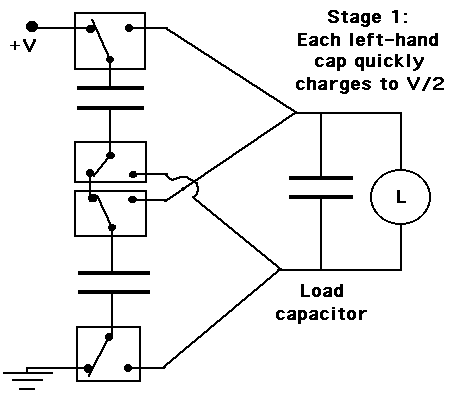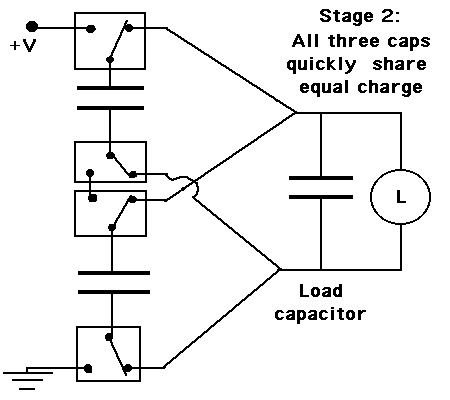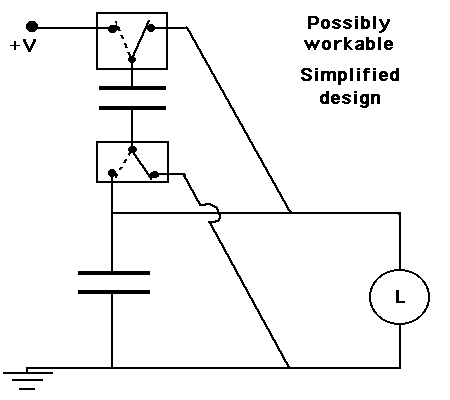
- Joined
- Apr 1, 2011
- Messages
- 15,807
- Helped
- 2,918
- Reputation
- 5,850
- Reaction score
- 3,069
- Trophy points
- 1,393
- Location
- Minneapolis, Minnesota, USA
- Activity points
- 118,373
I have managed to find my mistake in my unworkable method of pulsing current to the load and smoothing capacitor combined.
For a while I did not see a breakdown in efficiency between step 1 and 2:
(Step 1) A raw switch-on-switch-off configuration (95% efficient), and
(Step 2) the idea of adding a capacitor to smooth pulses.
I had to resort to my simulator. It showed me my mistake. It was not with the help of math or by theoretical axioms.
A solution to the OP should not care about a capacitor being (or not being) in the power supply. No need to calculate the decline in energy when a charge is distributed to a second capacitor. I used an ideal power supply. Zero ohms, no droop under load, no ripple. 3.3 V.
I discovered that the inefficiency enters in because the capacitor draws extreme current as it tries to charge to the full 3.3V while the pulse is on.
I tried the simulation with a small capacitor. A small cap reaches 3.3 V quickly. Then the pulse shuts off, and the cap discharges through the load quickly. This won't work. This is what I anticipated in the case of a small cap.
I tried a large cap. It charges a little higher with each pulse. The rate depends on the transistor's minimum 'on' resistance. I used 1 ohm. This makes resistive reduction a minor factor. I discovered a large capacitor does not end up settling at a charge of 1.2V to reflect a duty cycle of 35 percent (even though I thought it should). It seeks to reach 3.3 V, drawing extreme current during each pulse.
So now a couple of things are unsettling me:
* Finding my assertions were incorrect after I'd stated them confidently to those more knowledgeable than me,
* finding that a concept which is so good that it really ought to work, doesn't. Not with the efficiency it looked like it ought to have.
For a while I did not see a breakdown in efficiency between step 1 and 2:
(Step 1) A raw switch-on-switch-off configuration (95% efficient), and
(Step 2) the idea of adding a capacitor to smooth pulses.
I had to resort to my simulator. It showed me my mistake. It was not with the help of math or by theoretical axioms.
A solution to the OP should not care about a capacitor being (or not being) in the power supply. No need to calculate the decline in energy when a charge is distributed to a second capacitor. I used an ideal power supply. Zero ohms, no droop under load, no ripple. 3.3 V.
I discovered that the inefficiency enters in because the capacitor draws extreme current as it tries to charge to the full 3.3V while the pulse is on.
I tried the simulation with a small capacitor. A small cap reaches 3.3 V quickly. Then the pulse shuts off, and the cap discharges through the load quickly. This won't work. This is what I anticipated in the case of a small cap.
I tried a large cap. It charges a little higher with each pulse. The rate depends on the transistor's minimum 'on' resistance. I used 1 ohm. This makes resistive reduction a minor factor. I discovered a large capacitor does not end up settling at a charge of 1.2V to reflect a duty cycle of 35 percent (even though I thought it should). It seeks to reach 3.3 V, drawing extreme current during each pulse.
So now a couple of things are unsettling me:
* Finding my assertions were incorrect after I'd stated them confidently to those more knowledgeable than me,
* finding that a concept which is so good that it really ought to work, doesn't. Not with the efficiency it looked like it ought to have.







